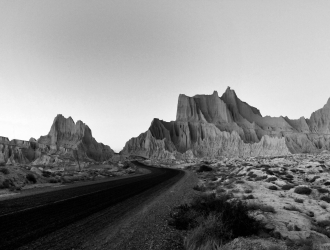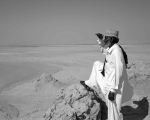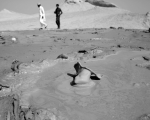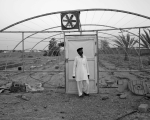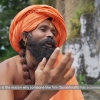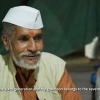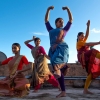As someone who grew up in Tehran, the vast desolation of Iran’s rugged countryside always attracted me. Noting my interest in photography, my brother suggested me to visit Negour town, capital of Dashtiari district in Sistan and Balochistan Province, where he had a friend, from his military service days, living there with his family. Therefore, in 2009, I travelled to Negur with my analog camera, the Nikon F100, and started my first documentary photography project. Since then, I have travelled to this remote corner of Iran on many occasions, spread over a decade.
Sistan and Balochistan Province is the only province in Iran which shares its border with both Afghanistan and Pakistan. Thus, this area is of great geo-political importance, not just in modern times but also historically. Balochistan lay at the periphery of great empires, fought over, conquered, but neglected as a backwater. It formed the eastern frontier of the Achaemenid Persian Empire under Darius the Great. In the epic poem Shahnameh, the national epic of Greater Iran, Balochi people are praised as brave warriors of Iran. In the fourth century BC, Alexander the Great of Macedon conquered Persia on his way to India. On the return journey, he force-marched his exhausted troops through Balochistan, losing thousands in the inhospitable desert. After a period of Hellenisation during the Seleucid Empire, the region came under rule of the Mauryan dynasty from India, forming its westernmost fringe. Next came the Indo-Scythians, known popularly as the Saka, after whom Sistan get its name (old Shakastan). They were followed by the Parthians, the Kushans and the Sassanids. Till this time, Balochistan had a mixed Hindu-Buddhist culture, as mentioned by the Chinese monk Xuanzang in his travel memoirs. In the seventh century, defeat of the Sassanids brought in Arab rule, and Islam was introduced in the region, which has since shaped the culture of this land. Even after this time, the Makran coast of Balochistan was considered the westernmost expanse of India, as mentioned by Al Biruni in Alberuni’s India, written in the eleventh century. In was only in the nineteenth century that Balochistan was divided between Iran and the expanding British Empire in India.
I took flight from Tehran to Konarak Airport, and continued to Dashtiari by road. My brother’s friend’s family was very welcoming and I was treated like one of their own. Though the province is predominantly settled by Balochi people, most people know Persian. Even with locals who did not speak Persian, communication was not difficult, since Balochi language, like Persian language, belongs to the Iranian language family and share mutual words. Being from the capital, I was always the center of attention. However, this made working much trickier, since they considered me more a guest who needed to be treated specially than a photographer who needs freedom to work.
Gradually, I made friends who took me to places I wanted to visit. Being a woman allowed me access to women-only spaces, but it did not necessarily ensure taking pictures freely. I had to take permission to shoot pictures of women, especially when they were smoking chillum, one of the few activities they can do same as men. I was told smoking chillum was feminine and smoking opium masculine! Meanwhile, being a woman, I had limitations visiting male-dominated places and events. Though such limitations for women were always there—for example, women are not allowed to visit mosque or graves—they have become stricter due to spread of Wahhabism among the Balochis. In Balochi culture, status of women is decided by a strict interpretation of the Sharia. Baloch men have rights to polygamy, unlike the rest of majority Shias in Iran, who practice monogamy. Moreover, the government of Iran impose compulsory hijab on all Iranian women, regardless of their religion or ethnicity. Hijab among the locals has gone beyond its norm and, in some cases, women wear niqab and cover their entire faces. As an educated, urban woman who could make her decisions independently, I was treated differently from the women of the households I visited. When I questioned this difference, they stated that local females are not educated enough to decide independently. A man should always accompany them in their decision making. However, my other question of why not give them enough freedom to gain social skills got me the answer: “It is not possible; Islam does not allow that.” Needless to say, Sunni Balochis are not fans of the moral values of the rest of non-Muslim/Shia Muslims of Iran, and they regard the freedom of other Iranian women—in comparison to Balochi women— the result of the lack of manliness of their male relatives.
However, over the last ten years, I have observed small changes. For example, families are now willing to sponsor their daughter’s education, and put less stress on early marriage. The introduction of internet and mobile phone has raised awareness about other parts of the country. Some Baloch have also traveled to other provinces, mostly seeking higher education or medical treatment. Tourism, though underdeveloped, has opened the region to the presence of national and international tourists. However, these changes are slow, mostly restricted to families who have access to social media. In reality, there is still a considerable gap between men and women’s status, and violence against women goes unchallenged and honor killings are not uncommon.
Unfortunately, the impact of Wahhabi ideology among Balochi people has put in danger the open practice of old Iranian customs. For example, older generations had mostly Iranian names, but names given to the new generation are almost entirely Arabic. Nowroz and other Iranian festivals which were earlier celebrated, are now rejected as non-Islamic culture, influenced by Wahhabi ideologies. Meanwhile, new movements are resisting Wahhabization of Balochi culture. Something which amazed me during my first tour was video clips made by Balochi people of their Aryan roots, shared via mobile phones. This attempt at acknowledging their Iranian origin while simultaneously following a strict version of Islam struck me deeply. A very small number of Balochi people are reverting to Zoroastrianism, the pre-Islamic religion of Greater Iran. Some others are content with the revival of old Iranian festivals, forgotten for decades.
The Location of Sistan and Balochistan on the Gulf of Oman (Makran coast) has resulted in ethnic mixing with non-Balochi people in the last 500 years. During the Safavid period, Makran coast came under attack from the Portuguese, who made their way to the Persian Gulf from bases in India.Portugal, which had established a vast maritime empire in the Indian Ocean, brought over Africans and Indians as part of the slave trade. These slaves, later on, were released and absorbed within the local population, mostly among Balochis living along the Makran coast. They call this group nokar (servants), emphasising their non-Balochi origin. The family I photographed belong to this group. Though they have Iranian passport like any other Iranian citizen, they have lower social standing in the region.
Balochi people, forming only a small portion of Iran’s population (they are only two per cent of Iran’s population) and due to their unfavorable location on a volatile border with Pakistan, did not actively take part in the political movements of Iran. However, due to increased communication through social media, understanding among the Balochis and other Iranians has increased in recent times. But being from the Sunni sect of Islam, Balochis remain vulnerable to Wahhabi influence, which is hardline, regressive and intolerant. This has hampered efforts in building confidence with the Shia-dominated central government, and Balochistan remains neglected and underdeveloped.
Lacking industry, the source of income of the people in the region is from agriculture, animal husbandry, handicrafts and business, at times, governmental jobs. Fishing in the Gulf of Oman is the mainstay for the people residing along the Makran coast, which stretches into Pakistan, all the way to Karachi. However, drought and flood periodically destroy agriculture, bringing great hardship for the locals. The region is deprived of necessary facilities like hospitals, schools and drinking water. Communication between the Balochis and other Iranians is limited to tourism, or through business in Chabahar port. Many from the province have left the country to migrate to neighboring Oman or some other developed countries of the Persian Gulf in search of better economic opportunities.

